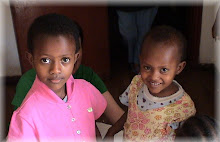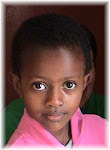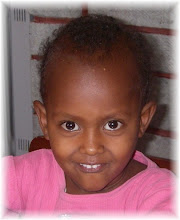Friday, February 29, 2008
The Health of Adopted Ethiopian Children
Here is some interesting and encouraging news from the International Adoption Clinic, in Boston, Massachussets. Below I have brought a quote from the site. But for those that want to read it at the site, here is the link to the article.
Since 2000, American families have adopted 1,700 children from Ethiopia. Little is known about the health and development of these children. Patients and Methods Retrospective chart review of the arrival health status of all 50 (26F:24M) children from Ethiopia/Eritrea seen in the International Adoption Clinic.
Prior to adoption, most children resided with relatives; 36% were >18 months old prior to entry into care. More than 50% were true orphans, often due to HIV. Arrival age ranged from 3 months to 15 years (mean +/- SD 4 years +/- 43.8 months). At arrival, growth z scores were near-average (weight -.59, height -.64, head circumference -.09); significantly better than adopted children Guatemala, China, or Russia seen in our clinic. However, some Ethiopian children were significantly growth delayed (WAZ
Medical issues on arrival included intestinal parasites (53%, [14% with >/=3 types]), skin infections (45%), dental caries (25%), elevated liver transaminases (20%), latent tuberculosis (18%), and hepatitis B (2%). Age-appropriate vaccines had been administered in 15-77% of children (depending on specific vaccine).
Behavior problems were uncommon. Gross/fine motor and cognitive skills were approximately 86% of expected for age. Age correlated inversely with developmental scores for cognition (r = -.49, P = .003). Five children had age reassignments.
Ethiopian/Eritean adoptees differ from other groups of internationally adopted children: they reside for relatively long periods of time with relatives prior to institutionalization, often have uncertain ages, exhibit few behavioral problems at arrival, have better growth, and may have less severe developmental delays. Whether these differences at arrival predict better outcomes for the Ethiopian/Eritrean children is unknown.
Since 2000, American families have adopted 1,700 children from Ethiopia. Little is known about the health and development of these children. Patients and Methods Retrospective chart review of the arrival health status of all 50 (26F:24M) children from Ethiopia/Eritrea seen in the International Adoption Clinic.
Prior to adoption, most children resided with relatives; 36% were >18 months old prior to entry into care. More than 50% were true orphans, often due to HIV. Arrival age ranged from 3 months to 15 years (mean +/- SD 4 years +/- 43.8 months). At arrival, growth z scores were near-average (weight -.59, height -.64, head circumference -.09); significantly better than adopted children Guatemala, China, or Russia seen in our clinic. However, some Ethiopian children were significantly growth delayed (WAZ
Medical issues on arrival included intestinal parasites (53%, [14% with >/=3 types]), skin infections (45%), dental caries (25%), elevated liver transaminases (20%), latent tuberculosis (18%), and hepatitis B (2%). Age-appropriate vaccines had been administered in 15-77% of children (depending on specific vaccine).
Behavior problems were uncommon. Gross/fine motor and cognitive skills were approximately 86% of expected for age. Age correlated inversely with developmental scores for cognition (r = -.49, P = .003). Five children had age reassignments.
Ethiopian/Eritean adoptees differ from other groups of internationally adopted children: they reside for relatively long periods of time with relatives prior to institutionalization, often have uncertain ages, exhibit few behavioral problems at arrival, have better growth, and may have less severe developmental delays. Whether these differences at arrival predict better outcomes for the Ethiopian/Eritrean children is unknown.
Subscribe to:
Post Comments (Atom)




















1 comment:
That is encouraging Justine. Thanks for posting. I have barely had time to start thinking about these sorts of details.
Barb
Post a Comment